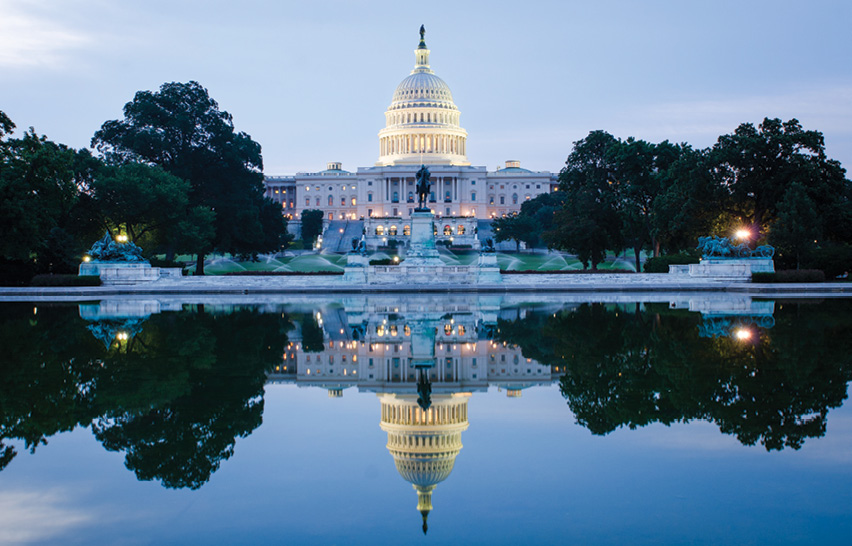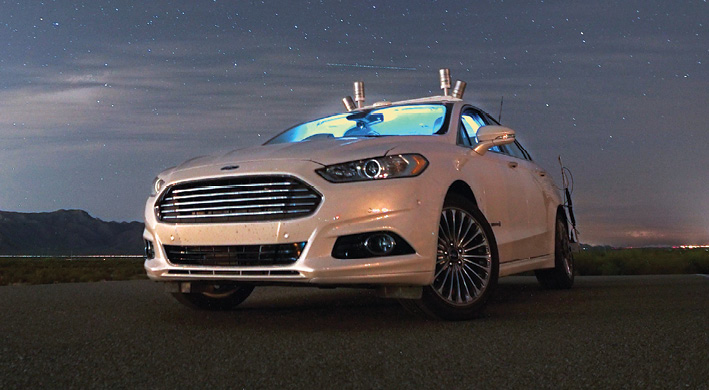
The House could vote in September on legislation opening the nation’s roads to potentially millions of vehicles equipped with autonomous technology.
Passed unanimously out of the House Energy and Commerce Committee, the SELF DRIVE Act (HR 3388) contains preemptions and exemptions designed to support the development of highly automated vehicles (HAVs) as well as privacy and cyber directives to protect their drivers and their passengers.
The bill actually comprises 14 different measures that were woven into a negotiated package with the privacy, preemption and exemption language the focus of the greatest wrangling between Republican and Democratic committee members.
Exemptions
In the same way that drones needed exemptions to fly because they couldn’t always conform to manned-aircraft requirements, fully- and partially-automated vehicles need exemptions to operate on the roadways when that automation technology doesn’t fit the current regulations.
Lawmakers are enthusiastic about driverless- and driver-assisted vehicles, including what the advantages to maintaining leadership in the technology could mean, but they are making a point of emphasizing the safety improvements that automated vehicles could bring.
“Traffic fatalities are on the rise,” Ohio Republican Bob Latta, chairman of the House Digital Commerce and Consumer Protection Subcommittee, told a June 27 hearing. “Last year there were over 40,000 fatalities and more than 2 million injuries on our nation’s highways. Our goal today is to enact the right policies to encourage self-driving technologies that can drastically reduce those numbers. We have a real opportunity to address this problem.”
The industry can’t move quickly however, say HAV advocates, because of limitations on how many vehicles can be allowed on the road between now—when standards and regulations are only beginning to be written—and the point when all the rules are in place.
“The auto industry is developing and deploying an array of automated vehicle technologies, transforming the conversation from crash survival to crash avoidance,” said John Bozzella, president and CEO of the Association of Global Automakers in his written testimony for the hearing. “These advancements are developing rapidly, and we can put vehicles on roadways now and in the near future that will help save lives while regulators develop the necessary policy framework. So the question is: What do we do in this interim period?”
There are already provisions to allow exemptions from some regulations for up to 2,500 vehicles so they can be driven in real-world conditions. The industry wants that number lifted dramatically to allow each company the latitude to deploy tens of thousands of vehicles, learning along the way and demonstrating their safety.
The current limit on exemptions of 2,500 is too strict to allow the industry to move quickly, explained David Strickland, who is counsel to the Self-Driving Coalition for Safer Streets. “The numerical and temporal limitations on exemptions under current law present a concrete obstacle to achieve the goal of rapid, safe, and robust deployment necessary to attain the safety and mobility benefits we believe the fully self-driving vehicles promise.”
This Is Not A Test
The bill, which was passed by the full committee July 27, would allow exemptions for 25,000 HAVs per manufacturer for the first year, 50,0000 the second year and 100,000 during the third and fourth years with a possibility of renewal. These exemptions are not aimed at testing but at establishing a broad base of on-the-road experience to be used to frame both the technology and the rules that eventually regulate it.
“The National Highway Traffic Safety Administration makes its decisions based upon data—whether or not they are going to take a rule-making posture, whether they’re going to think about creating a change to the new car assessment program,” Strickland said, “…all those things need data. The only way you get data, frankly, is deployment and usage—and that generates those necessary components.”
Under the 2,500-vehicle limit, he said, “there is no way you’re going to be able to generate the type of data information needed for, frankly, the companies to be able to innovate thoughtfully and, frankly, the agency to learn about those technologies.”
Given the number of automakers, the number of automated vehicles on U.S. roads could surge into the millions in a few short years—something that gives safety advocates pause.
There are “30-something” manufacturers who could eventually be making up to 100,000 cars a year that would operate under these exemptions, Alan Morrison told the hearing. Morrison is the Lerner Family Associate Dean for Public Interest and Public Service Law at George Washington University Law School in Washington, DC.
“Currently, when a company needs an exemption from a safety standard, they’re limited to 2,500 vehicles and it’s basically to test the new concept—to see if it’s going to work on the road,” said Henry Jasny, vice president and general counsel for Advocates for Highway and Auto Safety. The (National Highway Traffic Safety Administration or NHTSA) reviews their request and may ask the company to do certain things. But we’re talking about a drop in the bucket in terms of volume of vehicles when you’re talking about 2,500. So to up that to 100,000 per manufacturer per year—and to extend these (exemptions) from two, I think they extend it to four or five years—is a big change. Here we’re talking about mass production of vehicles with exemptions from current safety standards, and when you’re not sure exactly how those exemptions are going to work.”
Morrison pointed out that such “deployed” vehicles could be driven by anyone, including rental car customers, whereas only the auto manufacturers’ owners, operators and the specially trained people they hire would be allowed to drive test vehicles.

That could pose a risk not just to those on the roads but the industry itself, said Rep. Frank Pallone of New Jersey, the Energy and Commerce Committee’s ranking Democrat.
“Before we get to the deployment stage,” Pallone said, “when we are starting to allow individuals who are not specially trained to operate these vehicles, I think we have to be very, very careful.” There are real dangers, he said, of not just injuring people but also of injuring HAVs in the long run by undermining consumer confidence.
Preemptions
Part of the issue is NHTSA, which eventually will craft the final rules for HAVs, has only voluntary guidelines at this point. Moreover, the agency is currently leaderless, as the new administration has not yet nominated a person for the job of administrator.
“I am concerned that no one from NHTSA is here to testify,” said the subcommittee’s ranking member Jan Schakowsky, D-Illinois. “Agency feedback is critical. We need to be mindful of NHTSA’s current limitations and work to provide the data and resources it needs to be an effective consumer watchdog as the technology in our vehicles evolves.”
The other part of the issue, say safety advocates, is that the bill would preempt states from passing laws regulating HAVs, even if no federal regulations exists.
“If you preempt states then the states can’t come in—and they can act more swiftly if they see a problem,” Jansy said. “Even if they don’t get it totally 100 percent right for all vehicles they may be able to issue something that protects the health and safety of their own citizens in terms of limiting where the vehicles can operate or if they see some other problem that comes up. It would take several years to issue a regulation. They (NHTSA) can recall vehicles right away if they find a defect but it also takes them a long time to find a defect. So in that kind of situation there’s no one really to step in if the states are preempted.”
The preemptions are aimed at keeping states from creating scores of disparate regulations for self-driving vehicles—a hodge-podge that could make it more difficult for firms to develop the new technology and the industry.
“We don’t know that all of the rules would be different,” Jansy said. ‘For one thing California usually takes the lead. So right now a lot of states haven’t issued regulations and we don’t expect them to. So it’d probably be just a few states that are knowledgeable and activist in the area.”
Chairman Latta, however, made clear that federal preemption of state HAV regulations is essential.
“Whether it is a pickup truck, a car, or a van, how the vehicle works and its design should be the province of the federal government—as the case has been for more than 50 years,” Latta told the hearing. “…We simply cannot have cars that stop at state lines.’
The bill does mandate that NHTSA fulfill its rule-making role and not let the industry operate by exception indefinitely.
“NHTSA has to have a plan, and a framework for following through on that plan, to actually write new rules of the road for the next generation of vehicles,” said a congressional staffer, who asked for anonymity to be able to speak freely. “We’re not just giving exemptions to the current rules.”
“Exemptions are no substitute for updated safety standards as more AVs (automated vehicles) share the road,” Schakowsky said. “Exemptions should only be a stopgap as NHTSA determines how to update existing laws and what additional safety standards might be necessary for AVs. We need to figure out a responsible way to keep innovation moving forward while ensuring safety at every stage.”
Privacy, Cyber Protections
The bill would also bar manufacturers from offering either partially- or fully-automated vehicles until they have both a written privacy and cybersecurity plan in place.
The privacy plan must address “the collection, use, sharing, and storage of information about vehicle owners or occupants.” It must encompass how data is used by the company and the other entities it works with as well as the method for giving notice about the policy to vehicle owners and occupants. Enforcement of this provision would be in the hands of the Federal Trade Commission.
The cybersecurity plan has to detail how the company identifies and responds to cyber threats including its process for mitigating “reasonably foreseeable vulnerabilities.” Those vulnerabilities would include false or spurious messages and malicious efforts to take over control of the vehicle.
Auto companies must develop incident response plans, intrusion detection and prevention systems that safeguard key controls, systems, and procedures through testing or monitoring. They must also have a way to update their systems to address new threats and circumstances.
The auto industry has already established an industry operated ISAC, or information sharing and analysis center, said Mitch Bainwol, president and CEO of the Alliance of Automobile Manufacturers. These centers, which have been set up by other industries as well, aim to enhance cybersecurity awareness and boost collaboration among their members.
Interestingly, enforcement of these measures falls to the federal government under a section of 49 U.S. Code § 30165, which sets fines of $21,000 per violation per vehicle with a cap of $105 million.
The SELF DRIVE Act is likely to come up for a vote in the full House in September under rules that allow easier passage, the staffer said. Given its level of bipartisan support, they said, it will probably pass without a problem. “I mean it was a 54 to 0 vote out of the Energy and Commerce Committee.”
Senate lawmakers are also working on an automated vehicle bill but are taking a different approach, the staffer told Inside Unmanned Systems. A draft of that measure has yet to emerge.

